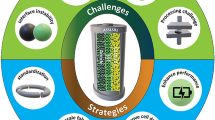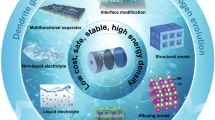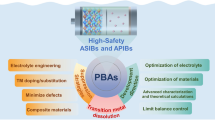Abstract
In this work, a computational framework is proposed by utilizing molecular dynamics simulation to explore the existing relation between molecular structure and ionic conductivity of the electrolyte system [LiPF6+(EC+DMC 1:1)] consisting of a mixture of cyclic ethylene carbonate (EC) and acyclic dimethyl carbonate (DMC) solvents and lithium hexafluorophosphate (LiPF6) salt to propose as a novel mixed organic solvent-based electrolytes to promote the performance of lithium-ion batteries (LIBs). To acquire a clear understanding of the structural and transport properties of the designed electrolytes, quantum chemistry (QC) calculations and molecular dynamics (MD) simulation are used. In the first step, the accurate molecular structures of the studied electrolytes in addition to their corresponding atomic partial charges are evaluated. The MD simulations are performed at 330 K varying the LiPF6 concentration (0.5 M to 2.2 M). Analysis of the obtained results indicated that ionic diffusivity and conductivity of the electrolytes are dependent on the structure of solvated ions and lithium salt (LiPF6) concentration. It is found that the obtained MD simulation results are in reasonable agreement with experimental results.

A representation of dependence of transport properties of electrolyte system [LiPF6 +(EC+DMC 1:1)] as function of salt concentration to be used in Lithium-ion batteries (LIBs).








Similar content being viewed by others
References
Nezam I, Peereboom L, Miller DJ (2017) Enhanced acrylate production from 2-acetoxypropanoic acid esters. Org Process Res Dev 21(5):715–719. https://doi.org/10.1021/acs.oprd.7b00047
Nezam I, Peereboom L, Miller DJ (2019) Continuous condensed-phase ethanol conversion to higher alcohols: experimental results and techno-economic analysis. J Clean Prod 209:1365–1375. https://doi.org/10.1016/j.jclepro.2018.10.276
Diederichsen KM, McShane EJ, McCloskey BD (2017) Promising routes to a high Li+ transference number electrolyte for lithium ion batteries. ACS Energy Lett 2:2563–2575. https://doi.org/10.1021/acsenergylett.7b00792
Huan L, Xie J, Chen M et al (2017) Theoretical investigation of pillar[4]quinone as a cathode active material for lithium-ion batteries. J Mol Model 23:105. https://doi.org/10.1007/s00894-017-3282-3
Lanjan A, Ghalami Choobar B, Amjad-Iranagh S (2020) Promoting lithium-ion battery performance by application of crystalline cathodes LixMn1−zFezPO4. J Solid State Electrochem 24:157–171. https://doi.org/10.1007/s10008-019-04480-6
Lanjan A, Ghalami Choobar B, Amjad-Iranagh S (2020) First principle study on the application of crystalline cathodes Li2Mn0.5TM0.5O3 for promoting the performance of lithium-ion batteries. Comput Mater Sci 173:109417. https://doi.org/10.1016/j.commatsci.2019.109417
Nyman A, Zavalis TG, Elger R et al (2010) Analysis of the polarization in a Li-ion battery cell by numerical simulations. J Electrochem Soc 157:A1236–A1246
Ghalami Choobar B, Modarress H, Halladj R, Amjad-Iranagh S (2019) Multiscale investigation on electrolyte systems of [(solvent + additive) + LiPF6] for application in lithium-ion batteries. J Phys Chem C 123:21913–21930. https://doi.org/10.1021/acs.jpcc.9b04786
Xu K (2014) Electrolytes and interphases in Li-ion batteries and beyond. Chem Rev 114:11503–11618
Jankowski P, Wieczorek W, Johansson P (2016) SEI-forming electrolyte additives for lithium-ion batteries: development and benchmarking of computational approaches. J Mol Model 23:6. https://doi.org/10.1007/s00894-016-3180-0
Skarmoutsos I, Ponnuchamy V, Vetere V, Mossa S (2015) Li+ solvation in pure, binary, and ternary mixtures of organic carbonate electrolytes. J Phys Chem C 119:4502–4515
Li Z, Smith GD, Bedrov D (2012) Li+ salvation and transport properties in ionic liquid/lithium salt mixtures: a molecular dynamics simulation study. J Phys Chem B 116:12801–12809. https://doi.org/10.1021/jp3052246
Xu K (2004) Nonaqueous liquid electrolytes for lithium-based rechargeable batteries. Chem Rev 104:4303–4417. https://doi.org/10.1021/cr030203g
Chaban VV, Andreeva NA (2016) Solvation of the morpholinium cation in acetonitrile. Effect of an anion. J Mol Model 22:26. https://doi.org/10.1007/s00894-015-2896-6
Wiemers-Meyer S, Jeremias S, Winter M, Nowak S (2016) Influence of battery cell components and water on the thermal and chemical stability of LiPF6-based lithium ion battery electrolytes. Electrochim Acta 222:1267–1271. https://doi.org/10.1016/j.electacta.2016.11.100
Chaban V (2015) Solvation of the fluorine containing anions and their lithium salts in propylene carbonate and dimethoxyethane. J Mol Model 21:172. https://doi.org/10.1007/s00894-015-2717-y
Yang CR, Wang YY, Wan CC (1998) Composition analysis of the passive film on the carbon electrode of a lithium-ion battery with an EC-based electrolyte. J Power Sources 72:66–70. https://doi.org/10.1016/S0378-7753(97)02655-4
Wang Y, Nakamura S, Ue M, Balbuena PB (2001) Studies to understand surface chemistry on carbon anodes for lithium-ion batteries: theoretical reduction mechanisms of ethylene carbonate. J Am Chem Soc 123:11708–11718. https://doi.org/10.1021/ja0164529
Wang Y, Balbuena PB (2005) Theoretical studies on cosolvation of Li ion and solvent reductive decomposition in binary mixtures of aliphatic carbonates. Int J Quantum Chem 102:724–733. https://doi.org/10.1002/qua.20466
Wan C, Hu MY, Borodin O et al (2016) Natural abundance 17O, 6Li NMR and molecular modeling studies of the solvation structures of lithium bis(fluorosulfonyl)imide/1,2-dimethoxyethane liquid electrolytes. J Power Sources 307:231–243. https://doi.org/10.1016/j.jpowsour.2015.12.120
Kumar N, Seminario JM (2016) Lithium-ion model behavior in an ethylene carbonate electrolyte using molecular dynamics. J Phys Chem C 120:16322–16332. https://doi.org/10.1021/acs.jpcc.6b03709
Hayamizu K (2012) Temperature dependence of self-diffusion coefficients of ions and solvents in ethylene carbonate, propylene carbonate, and diethyl carbonate single solutions and ethylene carbonate + diethyl carbonate binary solutions of LiPF6 studied by NMR. J Chem Eng Data 57:2012–2017. https://doi.org/10.1021/je3003089
Boyer MJ, Vilciauskas L, Hwang GS et al (2016) Structure and Li+ ion transport in a mixed carbonate/LiPF6 electrolyte near graphite electrode surfaces: a molecular dynamics study. Phys Chem Chem Phys 18:1–6. https://doi.org/10.1039/C6CP05140E
Porion P, Rodrigue Y, Tessier C (2013) Comparative study on transport properties for LiFAP and LiPF6 in alkyl-carbonates as electrolytes through conductivity, viscosity and NMR self-diffusion measurements. Electrochim Acta 114:95–104. https://doi.org/10.1016/j.electacta.2013.10.015
Borodin O, Smith GD (2009) Quantum chemistry and molecular dynamics simulation study of dimethyl carbonate: ethylene carbonate electrolytes doped with LiPF6. J Phys Chem B 113:1763–1776. https://doi.org/10.1021/jp809614h
Baboul AG, Curtiss LA (1999) Gaussian-3 theory using density functional geometries and zero-point energies. J Chem Phys 110:7650–7657. https://doi.org/10.1063/1.478676
Ponnuchamy V, Mossa S, Skarmoutsos I (2018) Solvent and salt effect on lithium ion solvation and contact ion pair formation in organic carbonates: a quantum chemical perspective. arXiv Prepr 1–26
Stich M, Göttlinger M, Kurniawan M et al (2018) Hydrolysis of LiPF6 in carbonate-based electrolytes for lithium-ion batteries and in aqueous media. J Phys Chem C 122:8836–8842. https://doi.org/10.1021/acs.jpcc.8b02080
Nyman A, Behm M, Lindbergh G (2008) Electrochemical characterisation and modelling of the mass transport phenomena in LiPF6-EC-EMC electrolyte. Electrochim Acta 53:6356–6365. https://doi.org/10.1016/j.electacta.2008.04.023
Ong MT, Verners O, Draeger EW et al (2015) Lithium ion solvation and diffusion in bulk organic electrolytes from first-principles and classical reactive molecular dynamics. J Phys Chem B 119:1535–1545
Frisch MJ, Trucks GW, Schlegel HB et al (2009) Gaussian 09, revision A. 1. Gaussian Inc, Wallingford 27:34
Curtiss LA, Raghavach Ari K, Redfern PC et al (1998) Gaussian-3 (G3) theory for molecules containing first and second-row atoms. J Chem Phys 109:7764–7776. https://doi.org/10.1063/1.477422
Kristyán S, Ruzsinszky A, Csonka GI (2001) Reproducing Gaussian-3 total energy using fitted atomic correlation parameters for the rapid estimation of correlation energy from partial charges method and Hartree−Fock results. J Phys Chem A 105:1926–1933. https://doi.org/10.1021/jp0018192
Curtiss LA, Redfern PC, Raghavachari K (2011) Gn theory. Wiley Interdiscip Rev Comput Mol Sci 1:810–825. https://doi.org/10.1002/wcms.59
Borodin O, Olguin M, Ganesh P et al (2016) Competitive lithium solvation of linear and cyclic carbonates from quantum chemistry. Phys Chem Chem Phys 18:164–175
Breneman CM, Wiberg KB (1990) Determining atom-centered monopoles from molecular electrostatic potentials. The need for high sampling density in formamide conformational analysis. J Comput Chem 11:361–373. https://doi.org/10.1002/jcc.540110311
Rizzo RC, Jorgensen WL (1999) OPLS all-atom model for amines: resolution of the amine hydration problem. J Am Chem Soc 121:4827–4836. https://doi.org/10.1021/ja984106u
McDonald NA, Jorgensen WL (1998) Development of an all-atom force field for heterocycles. Properties of liquid pyrrole, furan, diazoles, and oxazoles. J Phys Chem B 102:8049–8059. https://doi.org/10.1021/jp981200o
van der Spoel D, Lindahl E, Hess B et al (2005) Gromacs user manual version 4.0. Manuals 308. https://doi.org/10.1007/SpringerReference_28001
Frenkel D, Smit B (2001) Understanding molecular simulation: from algorithms to applications. Elsevier
Nosé S (1984) A unified formulation of the constant temperature molecular dynamics methods. J Chem Phys 81:511–519. https://doi.org/10.1063/1.447334
Hoover WG (1985) Canonical dynamics: equilibrium phase-space distributions. Phys Rev A 31:1695–1697. https://doi.org/10.1103/PhysRevA.31.1695
Martoňák R, Laio A, Parrinello M (2003) Predicting crystal structures: the Parrinello-Rahman method revisited. Phys Rev Lett 90:4. https://doi.org/10.1103/PhysRevLett.90.075503
Darden T, York D, Pedersen L (1993) Particle mesh Ewald: an N·log(N) method for Ewald sums in large systems. J Chem Phys 98:10089–10092. https://doi.org/10.1063/1.464397
Prausnitz JM, Lichtenthaler RN, De Azevedo EG (1999) Molecular thermodynamics of fluid-phase equilibria3rd edn. Pearson Education
Yamada Y, Yamada A (2015) Review—superconcentrated electrolytes for lithium batteries. J Electrochem Soc 162:A2406–A2423. https://doi.org/10.1149/2.0041514jes
Ravikumar B, Mynam M, Rai B (2018) Effect of salt concentration on properties of lithium ion battery electrolytes: a molecular dynamics study. J Phys Chem C 122:8173–8181. https://doi.org/10.1021/acs.jpcc.8b02072
Krachkovskiy SA, Bazak JD, Fraser S et al (2017) Determination of mass transfer parameters and ionic association of LiPF6: organic carbonates solutions. J Electrochem Soc 164:A912–A916. https://doi.org/10.1149/2.1531704jes
Jamali SH, Wolff L, Becker TM et al (2018) Finite-size effects of binary mutual diffusion coefficients from molecular dynamics. J Chem Theory Comput 14:2667–2677. https://doi.org/10.1021/acs.jctc.8b00170
Yeh I, Hummer G (2004) System-size dependence of diffusion coefficients and viscosities from molecular dynamics simulations with periodic boundary conditions. 15873–15879
Tenney CM, Cygan RT (2013) Analysis of molecular clusters in simulations of lithium-ion battery electrolytes. J Phys Chem C 117:24673–24684. https://doi.org/10.1021/jp4039122
Bockris JO (2000) Modern electrochemistry 2B: electrodics in chemistry, engineering, biology and environmental science. Springer Science & Business Media
Breitkopf C, Swider-Lyons K (2016) Springer handbook of electrochemical energy. Springer
Fong KD, Self J, Diederichsen KM et al (2019) Ion transport and the true transference number in nonaqueous polyelectrolyte solutions for lithium ion batteries. ACS Cent Sci 5:1250–1260. https://doi.org/10.1021/acscentsci.9b00406
Borodin O, Gorecki W, Smith GD, Armand M (2010) Molecular dynamics simulation and pulsed-field gradient NMR studies of Bis(fluorosulfonyl)imide (FSI) and Bis[(trifluoromethyl)sulfonyl]imide (TFSI)-based ionic liquids. J Phys Chem B 114:6786–6798. https://doi.org/10.1021/jp911950q
Mogurampelly S, Ganesan V (2015) Effect of nanoparticles on ion transport in polymer electrolytes. Macromolecules 48:2773–2786. https://doi.org/10.1021/ma502578s
Lesch V, Jeremias S, Moretti A et al (2014) A combined theoretical and experimental study of the influence of different anion ratios on lithium ion dynamics in ionic liquids. J Phys Chem B 118:7367–7375. https://doi.org/10.1021/jp501075g
Wheatle BK, Keith JR, Mogurampelly S et al (2017) Influence of dielectric constant on ionic transport in polyether-based electrolytes. ACS Macro Lett 6:1362–1367. https://doi.org/10.1021/acsmacrolett.7b00810
Wu YC, Koch WF (1991) Absolute determination of electrolytic conductivity for primary standard KCl solutions from 0 to 50°C. J Solut Chem 20:391–401. https://doi.org/10.1007/BF00650765
He X, Pu W, Han J et al (2005) Ionic limiting molar conductivity calculation of Li-ion battery electrolyte based on mode coupling theory. J Phys Chem B 109:23141–23144
Ue M (1994) Mobility and ionic association of lithium and quaternary ammonium salts in propylene carbonate and γ-butyrolactone. J Electrochem Soc 141:3336–3342. https://doi.org/10.1149/1.2059336
Author information
Authors and Affiliations
Corresponding author
Additional information
Publisher’s note
Springer Nature remains neutral with regard to jurisdictional claims in published maps and institutional affiliations.
Electronic supplementary material
ESM 1
(DOCX 1664 kb).
Rights and permissions
About this article
Cite this article
Haghkhah, H., Ghalami Choobar, B. & Amjad-Iranagh, S. Effect of salt concentration on properties of mixed carbonate-based electrolyte for Li-ion batteries: a molecular dynamics simulation study. J Mol Model 26, 220 (2020). https://doi.org/10.1007/s00894-020-04464-8
Received:
Accepted:
Published:
DOI: https://doi.org/10.1007/s00894-020-04464-8




